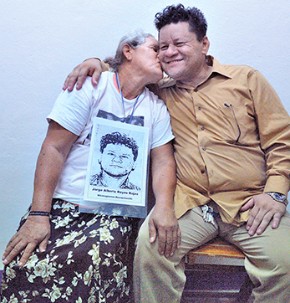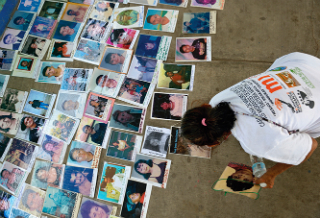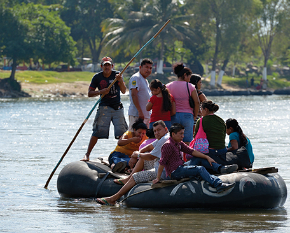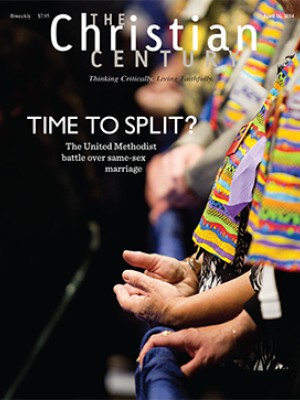Missing in Mexico: The search for Central American migrants

Santos del Socorro Rojas knew she’d find her son Jorge Reyes one day. She just wasn’t sure how. He’d gone north, as do many who flee poverty in Nicaragua, but after a few weeks they’d lost touch. The years went by and her anguish grew, until one day someone from the Jesuit Refugee Service knocked on her door and asked if she’d like some help.
That knock led Rojas to join a caravan of 45 Central Americans, mostly mothers looking for their disappeared children, who traveled to Mexico last December. Rojas was one of the lucky ones. On December 16 church workers were in Tapachula, a sprawling border city in the southern state of Chiapas, and took Rojas to a small shack where her son lived. After nine years of separation she embraced Reyes.
Read our latest issue or browse back issues.
“I always had faith. I knew the Lord would send me angels to help me find my child,” she said.
As hundreds of thousands of migrants pass through Mexico every year, angels are in short supply. There are plenty of devils—dressed as police or covered with gang tattoos—who are beating migrants, throwing them off trains if they can’t pay the “tax,” and forcing young migrant women into prostitution. Yet a feisty community of church activists remains committed to practicing hospitality toward the stranger, which in Mexico’s case starts with ending a very profitable pattern of violence.
The angel who appeared to Rojas and her son was Olga Sánchez Martínez, director of Jesus the Good Shepherd of the Poor and Migrant Shelter in Tapachula. The caravan visited the shelter, which provides care for migrants who’ve been injured or fallen ill on their way north, and someone recognized Reyes from the photo that his mother wore around her neck. They remembered that he once worked at a local carwash.
Sánchez and Rojas set off to follow the lead. The car wash had closed, but someone at a nearby car wash recognized the image and said Reyes lived near a certain bar. The group went there and found that Reyes had moved away two years ago. But a man there knew someone at a bicycle repair shop who had helped the Nicaraguan man move his belongings. Sánchez and Rojas tracked down that man, and he agreed to lead them to Reyes. Sánchez gave him money to put fuel in his motorcycle, and they followed him deep into one of the city’s poorest neighborhoods.
“He got off his motorcycle and disappeared into a warren of shacks, then reappeared and told us to wait a moment,” Sánchez said. “After a minute or so Jorge came out. He was a dead ringer for his mother! I thought his mother’s heart would burst through her chest with joy.”
The emotional encounter was one of 12 wonderful moments on the 16-day trip when members of the caravan either located their own family member or discovered someone else’s lost relative. The women carried hundreds of photos that they laid out on the ground in village plazas and other settings and asked everyone who passed by if they recognized anyone. (It was the ninth such caravan and produced more reunions than any of the previous ones.)
 |
| SEARCHERS: A woman helps lay out photos on the ground in Puerto Madero, Mexico, in December 2013. The photos were brought by a caravan of Central Americans, mostly mothers looking for their disappeared or trafficked children, who came to Mexico for 17 days. |
At times, however, the result wasn’t good news. In Puerto Madero, a fishing village on the Pacific coast west of Tapachula, a resident recognized one young woman’s photo. Caravan members traced her to a neighborhood where residents recognized the woman’s photo but said she had died four years ago of AIDS, contracted while working in the city’s bars. The young woman was buried in a nearby cemetery, but much of that burial ground, including the woman’s grave, had washed out to sea during a storm.
Members of the caravan held a demonstration along the Mexico-Guatemala border, pressing Mexican authorities for better treatment for migrants, including the implementation of transit visas, a measure that would allow migrants to abandon dangerous travel on freight trains and make them less vulnerable to abuse by criminal gangs and police.
Most participants returned home with more unanswered questions. Yet Iris Yaconda, a Nicaraguan psychologist who provided emotional support for caravan participants, says the women no longer feel isolated.
“These are women who live in constant grief, not knowing what happened to their loved ones. Their stages of grieving have no end. They suffer sleepless nights and depression. But in the caravan they found other women who are living through the same experience,” said Yaconda. “Despite not finding their loved ones, they push themselves to keep struggling, to claim their right to hope. They aren’t just victims. Their pain pushes them forward, not back into retreat. And knowing they have friends in so many places, other families and priests and shelters that care for the migrants, they know they aren’t alone.”
As the numbers of migrants passing through continues to rise, the migrants and their families will need all the friends they can find in Mexico. Many studies, including some by the Pew Research Center’s Hispanic Trends Project, indicate that the number of Mexican immigrants in the United States stabilized after 2007–2009. But current economic conditions and political repression farther south are driving record numbers of Hondurans, Guatemalans, and others to make the perilous journey north. Although deportations from the United States fell slightly from 2012 to 2013, the number of migrants flown home to Central America increased.
A November statement from 13 Catholic bishops on both sides of the U.S.-Mexico border recognized “a new flow of migrants from all social and economic classes” fleeing instability and violence in Central America. Particularly worrisome, the bishops reported, is a dramatic increase in the number of unaccompanied children and adolescents heading north in recent months. “This relatively new population of young migrants is particularly vulnerable to the abuse and exploitation of human traffickers,” the bishops stated.
As the numbers of northbound migrants steadily rise, many ordinary Mexicans have stepped forward to welcome them. Since 1995, women in Amatlán de los Reyes in the state of Veracruz have greeted the trains that roll through their town heavily laden with migrants. The women cook food and thrust it into the hands that reach out from the top and sides of moving trains. In nearby Tierra Blanca, women who live along the railroad tracks recently came out en masse with sticks and brooms to chase away a squad of police who were beating a group of migrants who had refused to pay bribes.
While such acts of solidarity may be tolerated, threats to the underlying profitability of migration won’t be. That’s why journalist Gregorio Jiménez was kidnapped in February and his body found in a shallow grave six days later. He had investigated a bar where several migrants had reportedly disappeared. Initial police reports indicate that the bar owner paid to have him silenced.
As dangerous as it has become for journalists in places like Veracruz, at least Jiménez’s killing got some public attention. Usually when a migrant suffers or dies, few people care because migrants have been so dehumanized in Mexican culture.
“Discrimination and xenophobia have increased in recent years,” said Father Heyman Vázquez Medina, a priest in Huixtla who runs the St. Francis of Assisi migrant shelter. “So to talk about a Central American today is to talk about a delinquent, a person who’s going to rob you and abuse all the women. Migrants are blamed for everything. If a migrant does something illicit, it’s big news. But when he or she suffers assassination, kidnapping, extortion, robbery, and beatings, no one says anything. If a migrant dies, no one says anything.”
Vázquez says the Mexican government isn’t interested in changing things.
“There’s collusion between the authorities and organized crime. The delinquents can charge migrants $100 to ride the train north, or they can kidnap migrants, and the government doesn’t do a thing. It’s really a policy of extermination,” he said.
In some places the government is worse than organized crime when it comes to mistreating migrants. A Catholic migrant shelter in Saltillo, Coahuila, documented 113 cases of human rights violations against immigrants occurring in the last six months of 2013. Forty-seven percent were caused by the federal police. The vicious Los Zetas cartel and the Mara Salvatrucha gang were responsible for 16 percent and 8 percent, respectively. The remaining cases were credited to state and municipal police forces.
Whatever force is behind this systemic violence, including 20,000 migrant kidnappings a year that produce an unknown sum of ransom payments from terrorized families back home or in the United States, the powerful send the message that they will not tolerate the church messing around in their business. That’s why Tomás González, a Franciscan friar who runs the Seventy-Two, a migrant shelter in Tenosique, Tabasco, has received repeated death threats from Los Zetas. The police force has provided him and several other migrant defenders with bodyguards—but this is the same police force that competes with Los Zetas to rob, extort, and terrorize the migrants.
The Seventy-Two takes its name from the body count of a 2010 massacre near the border with Texas. Los Zetas kidnapped 58 men and 14 women, squeezed them for ransoms, and then reportedly assassinated those who failed to follow orders.
 |
| JOURNEYS: Migrants and others cross the Suchiate River where it forms a border between Guatemala and Mexico. The river crossing is part of the main route that Central American migrants follow on their way north. |
González’s shelter is only one outpost on a string of safe houses along the migrant route north. It has become part of an underground railroad of sorts for the poor seeking economic opportunity in the north. Largely run by church folks, the group carries out a ministry of accompaniment with migrants. When migrants go missing and their families come to look for them, González and the others accompany them as they visit the morgues, prisons, brothels, hospitals, and cemeteries where migrants are likely to end up.
They also speak up for the need for immigration reform, which in Mexico means demanding a halt to the killing of migrants, as well as the provision of transit visas to those passing through on their way north. Such advocacy has obviously touched a nerve in the country’s body politic, threatening the profits of several important sectors, so pressure has mounted on the church’s leaders to reign in those who meddle with migrant issues.
As a result, last year Mexico’s Catholic bishops attempted to seize direct control of all but one of Mexico’s 54 migrant shelters, which have been run by the church’s Human Mobility Ministry—never a ministry on which the bishops kept a tight leash. Until now. The bishops are also moving to control more directly the many church-based migrant soup kitchens, health and education centers, and human rights groups that are run by grassroots activists under the large umbrella of the church. Rather than emerging from the concrete praxis of individual parishes and dioceses, these pastoral projects are now destined to become one more “top-down ecclesiastical project,” according to Alejandro Solalinde, a priest who runs a shelter in Ixtepec in Oaxaca—and who also has to have police bodyguards.
The impact of this restructuring on the church’s critical ministries with migrants remains to be seen. But activists like Solalinde are worried. “Life grows from the ground up,” he said. “Things look very different from above. They have to be solved on the ground.”





